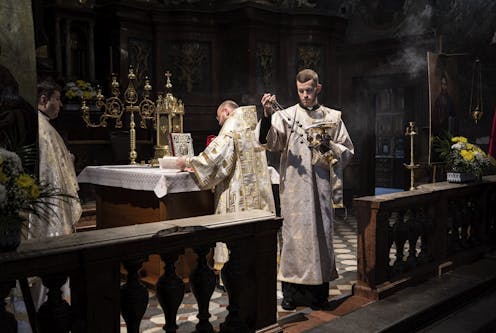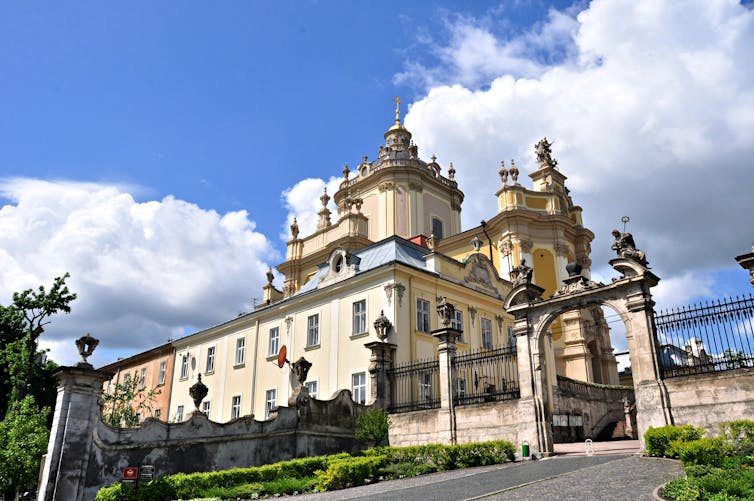Many Ukrainians are fleeing to the Greek Catholic Church in Lviv, which has a long and complex histo
The Ukrainian Greek Catholic Church has a history going back to the 16th century, when some Orthodox bishops and their followers agreed to become Catholic.

Since Russia invaded Ukraine, millions of refugees have fled westward to escape the fighting. Many have sought shelter in Ukraine’s westernmost city, Lviv, a historic center of the Ukrainian Greek Catholic Church, which has been providing essential services with the help of international Catholic charity networks. A major center of Greek Catholic life, the Archdiocese of Lviv has 306 parishes, over 400 priests, a seminary and a university.
Since its creation in the 16th century, this church has been an important cultural and intellectual resource for Ukrainian identity. Most Ukrainians regard themselves as Orthodox, not Catholic. But with anywhere from 4.5 million to 6.5 million members, the Ukrainian Greek Catholic Church is the third-largest church in Ukraine, representing about 10% to 15% of the Ukrainian population.
Despite its relatively small size, the Ukrainian Greek Catholic Church has, in the words of historian Kathryn David, “played an outsized role … in the creation of the Ukrainian nation.”
As a professor of religious studies who has spent three decades exploring the social and political role of religion in Eastern Europe, I am fascinated by the growing influence of the Ukrainian Greek Catholic Church in Ukraine.
A Catholic Church in an Orthodox country
As its name suggests, the Ukrainian Greek Catholic Church has a complex heritage. It is a Ukrainian church consisting of Ukrainian parishioners and headquartered in the Ukrainian capital of Kyiv.
The Ukrainian Greek Catholic Church is also Catholic. It recognizes the authority of the pope as the legitimate leader of all Christians. The head of the Ukrainian Greek Catholic Church, currently Major Archbishop Sviatoslav Shevchuk, is elected by a council of Ukrainian Greek Catholic Church bishops and confirmed by the pope. Catholic devotion to the Virgin Mary has also played an important role in Ukrainian Greek Catholic spiritual life, as anthropologists Vlad Neamescu and Agnieszka Halemba have shown.
At the same time, the Ukrainian Greek Catholic Church is Greek – which refers not to Greek ethnicity or language, but to the Greek Orthodox faith inherited from the Greek-speaking Byzantine Empire.
Ukrainian Greek Catholics follow the customs, laws and liturgy derived from the Orthodox Church. Notably, Ukrainian Greek Catholic parish priests are married and have families, unlike most Catholic priests.
History of the church

The Ukrainian Greek Catholic Church traces its origins back to the baptism of Grand Prince Volodymyr of Kyiv in the 10th century. Missionaries from the Byzantine Empire brought the Christian faith to Kyiv at a time when the Orthodox churches of the East and Roman Catholics in the West were still in communion with one another.
Just a few decades after Volodymyr’s conversion, however, the Orthodox and Catholic churches split in what historians have called the Great Schism. The two churches separated over ritual and political questions, including the authority of the pope. Catholics insisted that the pope had authority over the entire world. By contrast, Orthodox Christians considered him to have direct authority over only his own diocese of Rome.
At the time of the split, most Christians living on the territory of present-day Ukraine sided with the Orthodox Church. But by the end of the 16th century, the Catholic rulers of the Polish-Lithuanian Commonwealth controlled this territory. Fearful that they would simply be absorbed into the Roman Catholic Church, several Orthodox bishops agreed to join the Catholic Church under the condition that they be allowed to keep their Orthodox divine liturgy, rites, laws and customs.
The Council of Brest in 1596 solemnized this agreement. On the one hand, the Orthodox bishops and their spiritual flock agreed to become Catholic. They recognized the pope as the vicar of Christ and the true leader of all Christians.
On the other hand, the pope agreed that these new converts would form a special independent community within the Catholic Church. They would continue to follow Orthodox Church rituals, rules and practices. They would worship in Slavonic, not Latin. They would venerate icons – holy paintings of saints – rather than statues. They would observe the Orthodox calendar of feasts and fasts rather than the calendar used in the West. And their parish priests would marry and raise families, unlike most other Catholic priests, who must remain celibate. In this way, the Council of Brest created what is now called the Ukrainian Greek Catholic Church.
Taking up the Ukrainian national cause
In the late 18th century, Poland ceased to exist as a nation. Its territory was completely divided among its neighbors: Russia, Prussia and Austria. Russia, which took most of the area where Greek Catholics lived, suppressed the Greek Catholic Church. The Orthodox czars regarded Greek Catholics and their union with Rome as a security threat.
By contrast, the Catholic Habsburg rulers of Austria supported and subsidized the Greek Catholics. As a result, the Ukrainian Greek Catholic Church flourished in the Austrian-controlled province of Galicia, which is now in western Ukraine. The capital of Galicia, the city of Lemberg – now known as Lviv – became the most important center of Ukrainian Greek Catholic life and culture.
Under the leadership of Metropolitan Andrey Sheptytsky, who headed the church from 1901 until his death in 1944, the Ukrainian Greek Catholic Church became an “instrument of the Ukrainian national cause,” in the words of historian Paul Robert Magocsi. Both as a churchman and politician, Sheptytsky actively promoted Ukrainian autonomy and independence.
On the eve of World War II, the Ukrainian Greek Catholic Church had 4,400 parishes, 127 monasteries and a theological academy.
Persecution in the Soviet Union
During World War II, the officially atheist USSR annexed the territory that is now western Ukraine, where most Greek Catholics lived.
From 1946 to 1989, Soviet authorities repressed the Ukrainian Greek Catholic Church, which existed as an illegal underground organization in the USSR. The head of the church, Josyf Slipyi, spent 18 years in Soviet prison camps before being deported in 1963.
Only in 1989, thanks to the liberalizing reforms of General Secretary Mikhail Gorbachev, did the Ukrainian Greek Catholic Church emerge from the underground in the USSR and regain its legal status.
Ukrainian Greek Catholics in independent Ukraine
In 1991, Ukraine declared its independence. Although a minority Catholic Church in a predominantly Orthodox country, the Ukrainian Greek Catholic Church has become an increasingly significant national institution.
With its long history of support for Ukrainian culture and identity, its historical ties to Grand Prince Volodymyr and its links to both the Catholic and Orthodox traditions, the church offers an attractive religious alternative for Ukrainians seeking to join a national church.
Through its humanitarian work and its international contacts, the Ukrainian Greek Catholic Church has also provided effective responses to Russia’s illegal annexation of Crimea in 2014 and its full-scale invasion in 2022.
The Ukrainian Catholic University in Lviv has mobilized international support for its educational programs to rebuild Ukraine. Ukrainian Greek Catholic contacts with Rome, the European Union and North America have facilitated its charitable work during the war.
In the face of Russia’s persistent aggressive attacks on Ukraine, the Ukrainian Greek Catholic Church, I believe, will continue to play a vital role in caring for those who have been forced to flee from their homes because of the ongoing war.
J. Eugene Clay has received funding from the International Research and Exchanges Board, the Social Science Research Council, the National Endowment for the Humanities, and the National Humanities Center.
Read These Next
Why 2026 could see the end of the Farm Bill era of American agriculture policy
Farm bills – famously complex legislative and spending balances between farm subsidies, food assistance,…
Wearing a weighted vest can promote bone health and weight loss, but it’s not a cure-all
Are weighted vests more than a fitness fad? A health and exercise expert explains their potential benefits…
2026 begins with an increasingly autocratic United States rising on the global stage
The US attack on Venezuela highlights a shifting American foreign policy that dismisses a rules-based…






